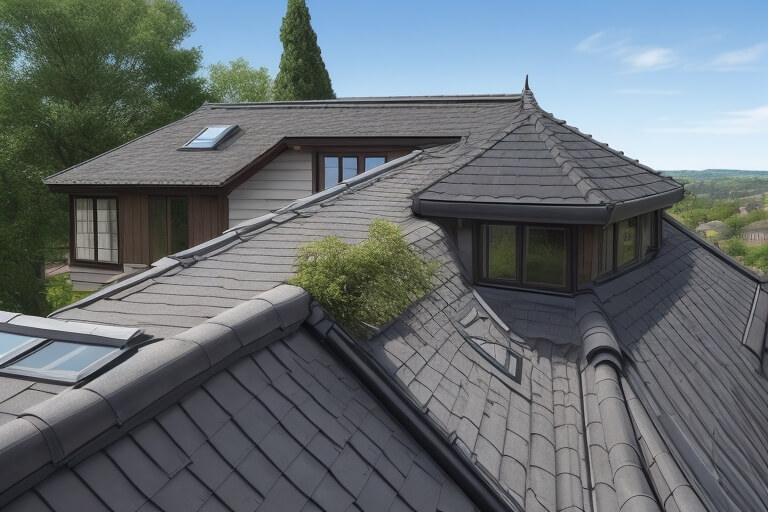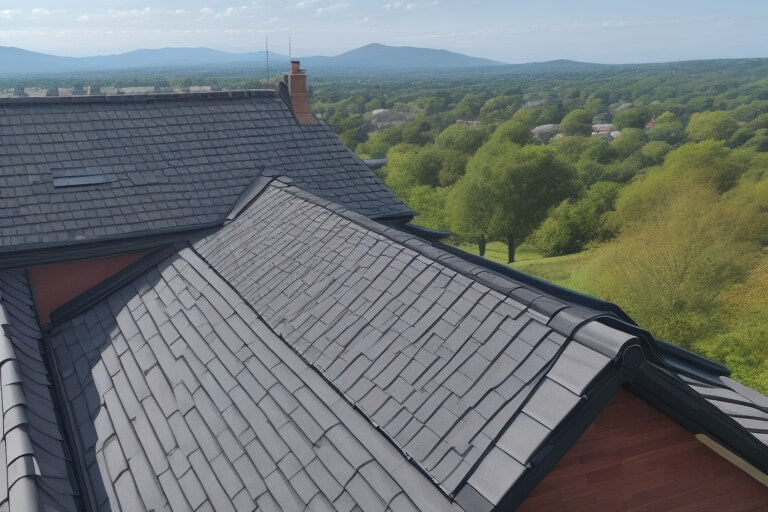When it comes to the elements that make up a functional and well-maintained home, roof ventilation is often overlooked or misunderstood. Homeowners tend to focus on more visible aspects of their property, such as the interior decor or the condition of their walls and floors. The role of proper roof ventilation cannot be underestimated.
Roof ventilation is a fundamental component of a well-designed home, yet it remains a somewhat underappreciated aspect of residential architecture. At its core, roof ventilation involves the strategic placement of intake and exhaust vents within the roof or attic space of a building. This system allows for the exchange of air, which, in turn, regulates the conditions within the attic. While it might sound simplistic, the impact of proper roof ventilation on the overall health and efficiency of your home is profound.
 Roof ventilation isn’t just about preventing your attic from becoming an unbearably hot or overly cold space; it’s about maintaining a delicate balance. Imagine your attic as a hidden ecosystem within your home, where temperature and humidity levels need to be controlled for optimal performance. Without this balance, your home can experience a host of problems, from premature wear and tear to increased energy consumption.
Roof ventilation isn’t just about preventing your attic from becoming an unbearably hot or overly cold space; it’s about maintaining a delicate balance. Imagine your attic as a hidden ecosystem within your home, where temperature and humidity levels need to be controlled for optimal performance. Without this balance, your home can experience a host of problems, from premature wear and tear to increased energy consumption.
The mechanics of roof ventilation are deceptively simple, yet they play a critical role in preserving the integrity of your home. The system operates based on the principles of natural airflow. Essentially, it facilitates the continuous exchange of air, ensuring that fresh air enters the attic space while stale, moist air is expelled.
This process begins with intake vents strategically placed in the lower portions of the roof, often near the eaves or soffits. These intake vents allow fresh, cooler air from the exterior to flow into the attic, displacing the warmer, moist air that tends to accumulate under the roof. The newly introduced air then circulates through the attic space, carrying away excess heat and moisture.
The final step in this ventilation dance is the exhaust vents, typically located near the roof’s peak or ridge. These vents provide an exit route for the heated air and moisture to escape, preventing them from stagnating within the attic. It’s important to note that this process isn’t a one-time event but rather a continuous cycle, maintaining a balanced and healthy environment within your attic throughout the year.
The Importance of Proper Roof Ventilation
One of the paramount reasons why proper roof ventilation is indispensable lies in its ability to take charge of temperature regulation within your home’s attic or roof space. It’s not uncommon for attics to become swelteringly hot during the scorching summer months. When the sun beats down on your roof, the temperature in the attic can soar to levels that are not only uncomfortable but also potentially damaging to your roofing materials.
Without adequate ventilation, this heat buildup can lead to shingles and roofing components deteriorating prematurely. Moreover, it can significantly raise the temperature within your home, causing your air conditioning system to work overtime, which results in inflated energy bills. Conversely, during the winter months, insufficient ventilation can give rise to a different problem: the formation of ice dams. These ice accumulations can wreak havoc on your roof, causing leaks and structural damage.
Moisture, if allowed to accumulate unchecked within your attic, can be the breeding ground for a host of problems. Excess humidity can lead to the growth of mold and mildew, which not only compromises indoor air quality but also poses health risks to occupants. Beyond this, moisture can cause wood components to rot, insulation to lose its effectiveness, and even compromise the structural integrity of your home.
Roof ventilation serves as a formidable ally in the battle against moisture. By facilitating a constant flow of air, it prevents the buildup of humidity within your attic. This, in turn, inhibits the conditions that foster mold and mildew growth while safeguarding the integrity of your home’s structural elements.
In an era when energy conservation is paramount, roof ventilation plays a crucial role in improving the overall energy efficiency of your home. During hot summers, a well-ventilated attic keeps temperatures in check, reducing the workload of your air conditioning system. This, in turn, translates to lower energy consumption and, consequently, reduced cooling costs.
In the winter, roof ventilation prevents the formation of ice dams and minimizes moisture buildup. This, in conjunction with adequate insulation, helps maintain a consistent indoor temperature, reducing the strain on your heating system and lowering heating bills. Proper roof ventilation, therefore, contributes not only to the comfort of your living spaces but also to the sustainability of your home.
Common Roof Ventilation Methods
Passive roof ventilation, despite its unassuming name, is a remarkably effective method of maintaining optimal attic conditions through the natural forces of convection and wind. This ventilation approach harnesses the power of passive airflow, which relies on the physical properties of warm air rising and cooler air sinking.
 The key components of passive roof ventilation include ridge vents, soffit vents, and gable vents. Ridge vents are installed along the peak of the roof, often blending seamlessly with the roofline’s design. They serve as exhaust points, allowing hot air to escape. Soffit vents, on the other hand, are located in the eaves or soffits, and they act as intake vents, drawing fresh air into the attic space. Finally, gable vents are strategically placed on the gable ends of the roof, facilitating additional air circulation.
The key components of passive roof ventilation include ridge vents, soffit vents, and gable vents. Ridge vents are installed along the peak of the roof, often blending seamlessly with the roofline’s design. They serve as exhaust points, allowing hot air to escape. Soffit vents, on the other hand, are located in the eaves or soffits, and they act as intake vents, drawing fresh air into the attic space. Finally, gable vents are strategically placed on the gable ends of the roof, facilitating additional air circulation.
This system works harmoniously, as warm air rises and exits through the ridge vents, while cooler air is drawn in through the soffit vents. The result is a continuous and natural flow of air that helps maintain an ideal temperature and moisture balance within the attic. Passive roof ventilation is not only energy-efficient but also cost-effective, as it operates without the need for mechanical components or power consumption.
Mechanical roof ventilation, in contrast to passive ventilation, involves the use of powered fans or vents to actively expel hot air and moisture from the attic. This approach is particularly beneficial in situations where natural ventilation is insufficient due to architectural constraints or local climate conditions.
Mechanical ventilation systems come in various forms, including attic fans, roof-mounted exhaust fans, and powered gable vents. These systems are designed to enhance the efficiency of airflow by providing a boost in the expulsion of hot air and moisture.
One of the advantages of mechanical roof ventilation is its adaptability. It can be controlled based on attic conditions, automatically activating when temperature or humidity thresholds are reached. This proactive approach ensures that your attic remains well-ventilated even during periods of stagnant air or extreme weather conditions.
While mechanical roof ventilation systems require electricity to operate, they offer a valuable solution in scenarios where natural ventilation alone may not suffice. They are particularly useful for homes in regions with hot and humid climates or when retrofitting an existing structure with ventilation needs that cannot be met by passive methods alone.